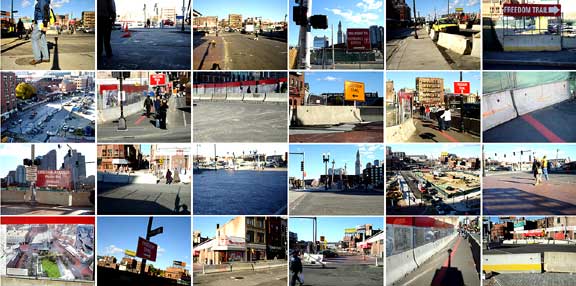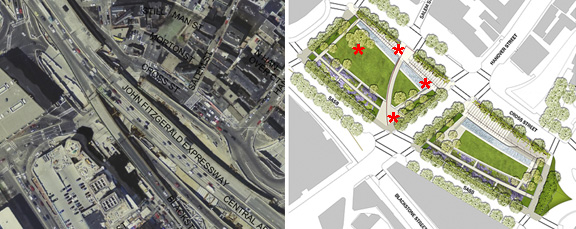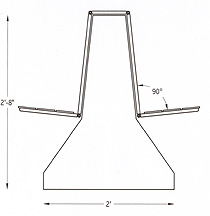jbba jersey
barrier bench attachment
this
project is generously funded by the LEF
Foundation's Public Art, Architecture and Design Grant
many thanks to the Artists
Foundation for sponsorship and support

Photo-collage showing existing conditions
of future north end park/freedom trail.
Jersey barriers were originally developed to divide
multi-lane highways in New Jersey. These barriers were intended to minimize
damage to vehicles, and to prevent them from veering into oncoming traffic
and causing fatal, head-on collisions. Today the barriers, which are
also known as K-rails, have evolved in both form and function, but the
original Jersey barrier design and use are still in high demand. The
barriers are used on construction sites, to block off restricted areas,
and more recently, to create a safe distance between surface streets
and vehicles and sensitive sites and monuments. Because government buildings
and historic monuments are now protected in this way, the barriers which
restrict vehicle intrusion also render these important civic places
unattractive and unfriendly for pedestrians. As what started as a temporary
safety measure becomes increasingly more permanent, widespread, and
unavoidable, a new way to reinterpret these barriers for the benefit
of the pedestrian population has become critical.
One way to render these temporary barriers more useful
and inviting is to work with their design to create street furniture
as versatile and temporary as the Jersey barriers themselves. The Jersey
barrier bench attachment (JBBA) is conceptually designed to invite residents,
tourists, office workers on their lunch breaks, and other urban pedestrians
to take advantage of these usually hostile intrusions. Both sides of
the bench comfortably seat four to five people, depending on the length
of the Jersey barrier. The design and materials of the bench have been
selected for maximum utility and longevity. The bench hangs from the
Jersey barrier, using its weight and mass to cantilever and support
the seats. The metal frame is lightweight, transportable, and strong.
The slatted wood bench design is taken from traditional picnic and park
benches to inspire welcoming familiarity. The high, sloping cross-section
of the barrier becomes a secure and comfortable place to relax, contemplate,
and people watch. The bench transforms the Jersey barrier from a spatial
divider to a social connector.

before and after: john fitzgerald expressway
(* potential sites for temporary installation).
The proposed site has been specially chosen for its
busy pedestrian traffic, from local residents and office workers to
national and international tourists. Its historical character will also
add context to the concept of the project. This site is part of the
Freedom Trail and was originally underneath the Fitzgerald Expressway,
which separated the North End district from Downtown Boston in the same
way a Jersey barrier divides a highway. This location is now the site
for future North End Park. The Jersey barriers currently in use on the
construction site could be recycled and strategically re-installed with
JBBA's as a temporary public art installation once the park is complete
or near completion. The goal for the Jersey barrier benches on this
specific site is for them to become symbols of its recent urban renewal
and remnants of the barrier that formerly divided the city.
 
basic jersey barrier specifications
and preliminary concept design drawing.
|